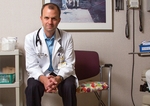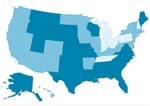government
Small practices may be least able to take new Medicaid patients
■ Low physician pay is a factor, and some question whether a temporary hike scheduled for 2013 and 2014 will make much of a difference.
- WITH THIS STORY:
- » Measuring who’s accepting new Medicaid patients
Washington A recent federal survey underscores the struggles some primary care and small practices face in taking on new Medicaid patients.
Most doctors — 96% — continue to accept new patients, Sandra L. Decker, PhD, an economist at the National Center for Health Statistics, found in polling more than 4,300 licensed, office-based physicians. But in comparing acceptance rates among various payment sources in 2011, Medicaid trailed behind Medicare and private insurance.
Of the doctors who responded to the survey, 31% expressed an unwillingness to take on new Medicaid patients, compared with 17% who didn’t want to accept new Medicare patients and 18% who said they weren’t going to accept new privately insured patients. Decker’s findings were published in the August Health Affairs. The sample population was drawn from the master files of the American Medical Association and the American Osteopathic Assn.
Low pay is certainly one reason why doctors don’t want to accept new Medicaid patients, but volume is another, said Matt Salo, executive director of the National Assn. of Medicaid Directors. An increasing number of people have been enrolling in Medicaid, “62 million and counting, with a huge bump coming in 2014,” when some states expand their programs under the Affordable Care Act, Salo said. “This drives budgetary pressure, which leads to even lower rates.”
Medicaid typically pays less than Medicare or private insurance, but a provision in the Affordable Care Act is scheduled to boost Medicaid payment for primary care physicians to Medicare rates in 2013 and 2014. Decker’s survey cited higher acceptance rates of new Medicaid patients in states with higher Medicaid-to-Medicare fee-for-service payment ratios. “Prior evidence suggests that physicians’ acceptance of Medicaid patients will increase as Medicaid payments increase,” reducing the need for hospitals to provide outpatient services while encouraging doctors to see Medicaid patients more frequently. However, “the fact that the planned increases are temporary could mitigate their impact,” Decker noted in her research.
A primary care issue
Primary care doctors must decide whether they’ll take new Medicaid patients under such a short-term improved payment schedule, said family physician Reid Blackwelder, MD, professor of family medicine at East Tennessee State University Quillen College of Medicine and a member of the American Academy of Family Physicians’ board of directors. The Medicaid parity bump is scheduled to expire just after major coverage expansions to Medicaid and the health insurance exchanges take effect in 2014, leaving some practices at an economic disadvantage. There also are concerns about tying Medicaid payments to Medicare, whose sustainable growth rate formula is scheduled for a 27% cut in January 2013 unless Congress intervenes.
Small practices — and, to a certain extent, primary care physicians — had lower-than-average acceptance rates of new Medicaid patients, according to the survey. Doctors practicing solo “were 23.5 percentage points less likely to accept new Medicaid patients than physicians in offices with at least 10 other physicians,” according to Decker’s research. Slightly more than 66% of primary care doctors in 2011 accepted new Medicaid patients, compared with nearly 72% in other specialties.
Medicaid physicians get paid just 37% of Medicare rates in New Jersey, the state that Decker’s survey ranked as the lowest in the country for accepting new Medicaid patients, followed by California. Just 40% and 57% are accepting them in New Jersey and California, respectively. Seventeen states are below the 69% overall percentage of Medicaid patient acceptance.
Lawrence Downs, CEO and general counsel of the Medical Society of New Jersey, said previous administrations haven’t put up enough money to achieve a reasonable federal match payment in a state that has high costs for rents, salaries and insurance, “everything you need to do to operate a business.” Given the economics, physicians in the state often see patients on a pro bono basis “rather than enroll in a program that pays less than they need to provide the care.”
AMA President Jeremy A. Lazarus, MD, said low Medicaid pay rates are a problem. “Payments to physicians who treat Medicaid patients are far too low and have not kept up with the cost of providing care,” he said. “The Medicaid system is an important safety net and provides health care coverage to the neediest Americans. The AMA will continue to advocate for bringing Medicaid payments in line with the actual cost of caring for patients to ensure access to high-quality care in all states.”
Rural bright spots
Dr. Blackwelder looked at Decker’s research from a slightly different perspective. He said although it’s true that small and solo practices can accommodate only so many Medicaid patients in states where payments are low, it’s encouraging that nearly all physicians are accepting them in a state like Wyoming, where the rate is 99%. “I think a lot of solo, smaller practices in rural areas are used to taking care of patients regardless of the payment,” he said.
At least among family physicians, acceptance rates of new Medicaid appears to be increasing, according to AAFP practice profile data. Compared with 2008, when acceptance rates were 55%, this figure rose to nearly 58% in 2009 and increased again to 64% in 2010.
Dr. Blackwelder speculated that some of this could be attributed to more patients changing their insurance to Medicaid during the recession and physicians keeping their doors open for them, “realizing that some payment may be better than no payment,” he said. Decker’s study did not define whether a “new” Medicaid patient included a current patient who was newly enrolled in the plan after having private or no insurance.
The American College of Physicians, in surveying more than 3,000 of its members in 2011, reported that 34% of internists were not accepting new Medicaid patients into their practices.
Downs said Medicaid payments will have to be raised somewhere in the range of Medicare “if we’re going to see more access for patients who will be coming on the rolls in 2014.”
All new patients gaining coverage through Medicaid in the next few years are going to have to find a physician, Dr. Blackwelder said. The hope is “that all of us will step up and take care of those patients.”












